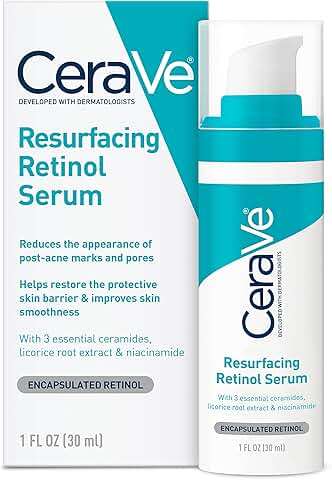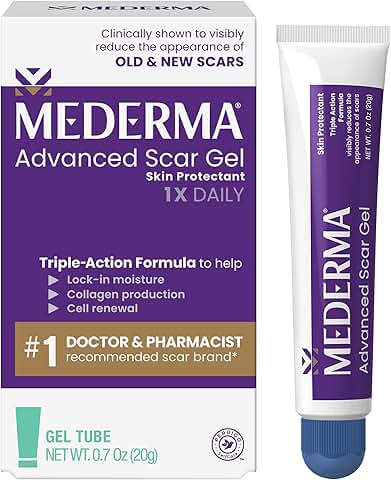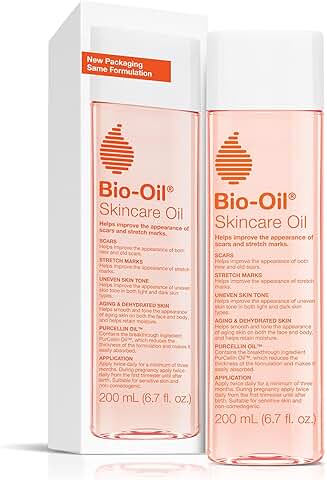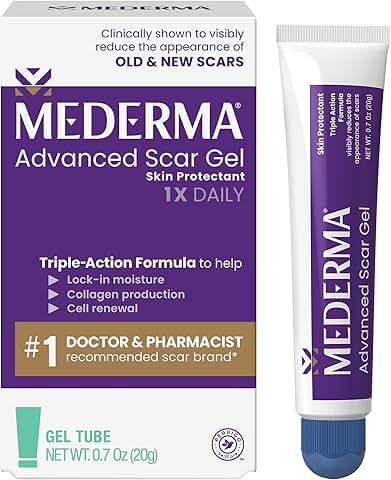I’ve extensively researched and analyzed various acne scar treatments, focusing on creams, gels, serums, and oils. What I uncovered is that each type of product offers unique benefits for different skin types and scar conditions.
The key to success comes from choosing the right formulation for your specific needs and consistently applying it over time.
Creams are typically thicker and more moisturizing, making them ideal for dry or mature skin. They often contain ingredients like hyaluronic acid or ceramides to hydrate and plump the skin, potentially reducing the appearance of shallow scars. Gels, on the other hand, have a lighter consistency and are better suited for oily or acne-prone skin. They’re often formulated with ingredients like salicylic acid or niacinamide, which can help control excess oil while treating scars.
Serums are highly concentrated formulations that penetrate deeply into the skin. They’re excellent for delivering potent active ingredients like vitamin C or retinol, which can help fade discoloration and stimulate collagen production. Oils are rich in fatty acids and vitamins, providing intense nourishment and potentially improving skin elasticity.
They’re particularly beneficial for dry or sensitive skin types.
The frequency of application varies depending on the product and it’s active ingredients. Generally, most treatments should be applied once or twice daily, but it’s crucial to follow the specific instructions provided with each product.
As for visible results, patience is key.
While some products may show initial improvements within a few weeks, significant changes typically take 2-3 months of consistent use.
For lasting effectiveness, it’s recommended to continue using the product for at least 3-6 months, even after seeing improvements. This allows the skin to fully regenerate and helps maintain the results achieved. After this period, you may be able to reduce the frequency of use or switch to a maintenance routine.
Now, let’s review four popular acne scar treatments:
1. CeraVe Resurfacing Retinol Serum
CeraVe’s Resurfacing Retinol Serum is a powerhouse product designed to tackle post-acne marks and improve overall skin texture. It’s formulation includes retinol, a proven ingredient for promoting cell turnover and collagen production.
The addition of licorice root extract and niacinamide helps brighten the skin and reduce the appearance of pores.
What sets this serum apart is it’s inclusion of ceramides, which help strengthen the skin barrier. This is particularly beneficial for people who have sensitive skin who might be concerned about the potential irritation from retinol.
The non-comedogenic formula confirms it won’t clog pores, making it suitable for acne-prone skin.
Users typically see initial improvements in skin texture within 4-6 weeks, with more significant results in scar reduction after 2-3 months of consistent use. For best results, apply a pea-sized amount to clean skin every evening, followed by a moisturizer.
2. Mederma Advanced Scar Gel
Mederma’s Advanced Scar Gel is a versatile treatment that targets both old and new scars, including those from acne. It’s key ingredient is Cepalin, a proprietary botanical extract that helps improve the overall appearance of scars.
This gel-based formula is lightweight and absorbs quickly, making it suitable for all skin types, including oily and combination skin. It’s particularly effective for raised scars, helping to soften and flatten them over time.
For optimal results, Mederma recommends applying the gel once a day for 8 weeks on new scars, or 3-6 months on older scars. Users often report noticeable improvements in scar texture and color within 4-8 weeks, with continued enhancement over several months.
3. Bio-Oil Skincare Body Oil
Bio-Oil is a multi-purpose skincare oil that’s gained popularity for it’s effectiveness in treating scars and stretch marks. It’s unique formulation includes a blend of plant extracts and vitamins suspended in an oil base, allowing for deep penetration into the skin.
The oil is particularly beneficial for people who have dry or mature skin, as it provides intense hydration while working to improve skin elasticity and tone. It contains vitamin A and E, which can help stimulate skin cell renewal and protect against free radical damage.
While it can be used on the face, those with oily or acne-prone skin should exercise caution and perform a patch test first. For best results, massage Bio-Oil into the affected areas twice daily for a minimum of 3 months.
Many users report seeing improvements in scar appearance and overall skin texture within 4-6 weeks, with more significant results after consistent long-term use.
4. Cicatricure Face and Body Advanced Scar Gel
Cicatricure’s Advanced Scar Gel is a comprehensive treatment designed to address various types of scars, including those from acne, surgery, and injuries. It’s formula includes ingredients like allantoin and centella asiatica, known for their skin-healing and collagen-stimulating properties.
This gel-based product is suitable for all skin types and can be used on both the face and body. It’s lightweight texture makes it particularly appealing for people who have oily or combination skin.
For optimal results, Cicatricure recommends applying the gel twice daily for at least 3 months. Users often report seeing initial improvements in scar texture and color within 4-6 weeks, with more significant results becoming obvious after 2-3 months of consistent use.
| Product | Best For | Application Frequency | Initial Results | Recommended Use Duration |
|---|---|---|---|---|
| CeraVe Resurfacing Retinol Serum | All skin types, especially sensitive | Once daily (evening) | 4-6 weeks | 3-6 months |
| Mederma Advanced Scar Gel | All skin types, raised scars | Once daily | 4-8 weeks | 8 weeks (new scars), 3-6 months (old scars) |
| Bio-Oil Skincare Body Oil | Dry or mature skin | Twice daily | 4-6 weeks | Minimum 3 months |
| Cicatricure Advanced Scar Gel | All skin types, face and body | Twice daily | 4-6 weeks | Minimum 3 months |
Each of these products offers unique benefits for treating acne scars. The CeraVe serum stands out for it’s gentle yet effective retinol formulation, making it suitable for a wide range of skin types.
Mederma’s gel is particularly effective for raised scars, while Bio-Oil excels in providing intense hydration for dry skin. Cicatricure offers a versatile solution for both face and body scars.
When choosing an acne scar treatment, consider your skin type, the nature of your scars, and your specific skincare concerns. Remember that consistency is key, and it may take several months of regular use to see significant improvements.
Always perform a patch test before introducing a new product into your skincare routine, especially if you have sensitive skin.
Understanding Acne Scars: Types, Causes, and Effective Treatment Strategies
Acne scars are a common and often distressing aftermath of acne breakouts. They can continue long after the acne itself has cleared, affecting the texture of the skin and your self-esteem.
Understanding the different types of acne scars, their causes, and the most effective treatment strategies is crucial for anyone looking to improve their skin’s appearance and regain confidence.
Types of Acne Scars
Acne scars come in various forms, each requiring a different approach to treatment. The main types include:
- Atrophic scars: These are depressed scars that sit below the surrounding skin level.
They’re further categorized into:
- Ice pick scars: Deep, narrow scars that extend into the dermis
- Boxcar scars: Round or oval depressions with steep vertical sides
- Rolling scars: Wide depressions with rounded, sloping edges
- Hypertrophic scars: These are raised scars that sit above the surrounding skin level.
- Keloid scars: Similar to hypertrophic scars but extend beyond the original acne spot.
- Post-inflammatory hyperpigmentation (PIH): These are flat, darkened patches of skin that aren’t true scars but can continue for months or years.
Causes of Acne Scarring
Acne scars form as part of the skin’s healing process following damage caused by inflamed acne lesions. Several factors contribute to their development:
- Severity of acne: More severe, deep, and inflamed acne is more likely to result in scarring.
- Delayed or inadequate treatment: Not treating acne promptly or effectively can increase the risk of scarring.
- Genetics: Some people are genetically predisposed to scar more easily.
- Picking or squeezing acne: This can introduce more bacteria and increase inflammation, leading to more severe scarring.
- Age: As we age, our skin loses collagen and elasticity, making it more prone to scarring.
Effective Treatment Strategies
Treating acne scars often requires a multi-faceted approach. Here are some of the most effective strategies:
1. Topical Treatments
Topical treatments are often the first line of defense against acne scars. They can help improve the appearance of scars and prevent new ones from forming.
Key ingredients to look for include:
- Retinoids: These vitamin A derivatives stimulate collagen production and promote cell turnover.
- Vitamin C: A powerful antioxidant that can help fade hyperpigmentation and boost collagen production.
- Niacinamide: Helps improve skin elasticity and reduce inflammation.
- Alpha Hydroxy Acids (AHAs): These exfoliating acids can help improve skin texture and fade discoloration.
2. Professional Treatments
For more severe scarring, professional treatments may be necessary. These include:
- Chemical peels: These use strong acids to remove the top layer of skin, promoting new skin growth.
- Microneedling: Tiny needles create controlled micro-injuries to stimulate collagen production.
- Laser therapy: Various types of lasers can target different scar types and skin concerns.
- Dermal fillers: These can help plump up depressed scars temporarily.
3. Natural Remedies
While not as potent as medical treatments, some natural remedies may help improve the appearance of mild acne scars:
- Aloe vera: Known for it’s soothing and healing properties.
- Honey: Has antibacterial properties and can help moisturize the skin.
- Rosehip oil: Rich in vitamins and essential fatty acids that can help improve skin texture.
4. Lifestyle Changes
Certain lifestyle changes can support your skin’s healing process and prevent future scarring:
- Sun protection: Always wear sunscreen to prevent hyperpigmentation from worsening.
- Healthy diet: A diet rich in vitamins and antioxidants can support skin health.
- Stress management: High stress levels can exacerbate acne and slow healing.
- Proper skincare routine: Gentle cleansing and moisturizing can help maintain skin health.
| Treatment Type | Best For | Expected Results | Downtime |
|---|---|---|---|
| Topical Treatments | Mild to moderate scarring, hyperpigmentation | Gradual improvement over months | None |
| Chemical Peels | Surface-level scars, uneven texture | Noticeable improvement after 3-6 treatments | 3-7 days |
| Microneedling | Atrophic scars, overall texture improvement | Significant improvement after 3-6 sessions | 2-3 days |
| Laser Therapy | Various scar types, severe scarring | Dramatic improvement possible, results vary | 5-10 days |
When it comes to treating acne scars, patience and consistency are key. Most treatments need many sessions or prolonged use to achieve optimal results.
It’s also important to have realistic expectations – while significant improvement is possible, finish elimination of scars may not always be achievable.
For those dealing with acne scars, products like CeraVe Resurfacing Retinol Serum can be an excellent starting point. It’s combination of retinol, niacinamide, and ceramides addresses many aspects of scar treatment – promoting cell turnover, reducing inflammation, and supporting the skin barrier.
For raised scars, Mederma Advanced Scar Gel or Cicatricure Face and Body Advanced Scar Gel can be effective options.
Those with dry or mature skin might benefit from the nourishing properties of Bio-Oil Skincare Body Oil.
Remember, what works best can vary from person to person. It’s always advisable to ask with a dermatologist for a personalized treatment plan, especially for severe or persistent acne scars.
My Experience with CeraVe Resurfacing Retinol Serum: A Journey to Smoother Skin
As someone who has battled with acne scars and uneven skin texture for years, I was eager to try CeraVe Resurfacing Retinol Serum. After incorporating it into my nightly skincare routine for several weeks, I’ve noticed some encouraging improvements in my skin’s overall appearance and texture.
Initial Impressions and Application
When I first started using the CeraVe Resurfacing Retinol Serum, I was impressed by it’s lightweight texture. It absorbed quickly into my skin without leaving any greasy residue, which is crucial for my combination skin type.
The pump dispenser made it easy to control the amount of product, and I found that a pea-sized amount was sufficient to cover my entire face.
I began by using the serum every other night, gradually increasing to nightly use as my skin adjusted. This cautious approach helped minimize any potential irritation, which is a common concern with retinol products.
Noticeable Changes
After about four weeks of consistent use, I started to notice subtle improvements in my skin’s texture. The small bumps and rough patches that had long been a source of frustration began to smooth out.
By the six-week mark, some of my more shallow acne scars appeared less noticeable, and my overall complexion looked brighter.
One of the most significant changes I observed was the reduction in post-acne marks. The reddish-brown spots that typically lingered after breakouts faded more quickly than usual, which I attribute to the combination of retinol and niacinamide in the formula.
Long-Term Benefits
As I continued using the serum for several months, the improvements became more pronounced. My skin felt firmer, and the texture continued to refine. Even some of my deeper acne scars seemed less obvious, though they didn’t disappear completely.
I particularly appreciated how the serum didn’t cause excessive dryness or peeling, which I’ve experienced with other retinol products in the past. The inclusion of ceramides in the formula likely played a role in maintaining my skin’s moisture barrier.
Frequently Asked Questions
How long does it take to see results from CeraVe Resurfacing Retinol Serum?
Most users, including myself, start to notice initial improvements in skin texture within 4-6 weeks. More significant results in scar reduction typically become obvious after 2-3 months of consistent use.
Can I use CeraVe Resurfacing Retinol Serum if I have sensitive skin?
While the serum is formulated to be gentle, those with sensitive skin should start slowly, using it 1-2 times a week and gradually increasing frequency. Always perform a patch test before full application.
Is it safe to use CeraVe Resurfacing Retinol Serum during the day?
It’s best to use this serum at night, as retinol can increase skin sensitivity to sunlight. If used during the day, always follow with a broad-spectrum sunscreen.
Can CeraVe Resurfacing Retinol Serum be used with other acne treatments?
It’s generally safe to use with other acne treatments, but be cautious about combining it with other potent active ingredients like benzoyl peroxide or salicylic acid, as this may increase irritation. Consult with a dermatologist for personalized advice.
My Favorite Aspects
What I appreciate most about the CeraVe Resurfacing Retinol Serum is it’s gentle yet effective formula. The combination of retinol with soothing ingredients like ceramides and niacinamide makes it suitable for regular use without causing excessive irritation.
I also love how it seamlessly integrates into my existing skincare routine, layering well under moisturizer and not pilling or balling up.
The fragrance-free formula is another big plus for me, as I prefer to avoid added scents in my skincare products. This makes it a great option for people who have sensitive skin or fragrance sensitivities.
Overall
While CeraVe Resurfacing Retinol Serum isn’t a secret cure for acne scars, it has been a valuable addition to my skincare routine. It’s helped improve my skin’s texture, fade post-acne marks, and give my complexion a more refined appearance.
The gentle formulation makes it accessible for those new to retinol or with sensitive skin.
For anyone dealing with acne scars, uneven texture, or looking to incorporate a retinol product into their routine, I would recommend giving CeraVe Resurfacing Retinol Serum a try. It offers a good balance of effectiveness and gentleness, making it suitable for a wide range of skin types.
Remember, consistency is key with any skincare product, especially those targeting concerns like acne scars. While my experience has been positive, results can vary from person to person.
It’s always a good idea to talk to a dermatologist if you have specific skin concerns or are unsure about introducing new products into your routine.
CeraVe Resurfacing Retinol Serum has earned a permanent spot in my skincare regimen.



